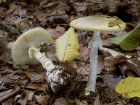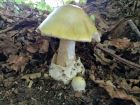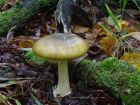Cap at first round to egg-shaped and then flat and varies greatly in colour from grey-white to green and yellow-brown, with darker innate radial fibrillae, which start from the centre and branch out towards the margin. Sometimes with lots of veil remnants. The margin is usually not striate. The flesh is white throughout, unchanging when sliced. Gills free, close or crowded, broad, white but sometimes with a slight greenish tint. Stem more or less equal, or it may taper towards the apex and flare towards the swollen base. The stem also features a white, skirt-like ring that typically persists but can sometimes be lost. Finally, the stem has a sack-like white volva that encases the base, which may be visible above ground or may be broken up or underground. Spore print white.
Microscopic Features: The spores are ellipsoidal to subglobose in shape, with a smooth surface. They measure 7.5-10 µm in length and 6-7 µm in width. They are inamyloid.
Amanita phalloides on the First Nature Web site.
Amanita phalloides on the MushroomExpert.Com Web site.
The first photo is by Archenzo under the CC BY-SA 3.0 license.
Many mushrooms are poisonous, and some can be lethally toxic. Distinguishing between edible and poisonous mushrooms can be very challenging. Therefore, we strongly advise against consuming wild mushrooms. This website does not contain any information about the edibility or toxicity of mushrooms.
Although efforts have been made to ensure accuracy on this website, the information may contain errors and omissions. Therefore, all content provided is for educational and informational purposes only and should not be relied upon or used as a basis for consuming any plants or mushrooms.
External links are provided for reference only. We do not endorse or take responsibility for the content, advice, or products found on these sites or in any advertisements shown on this website.



